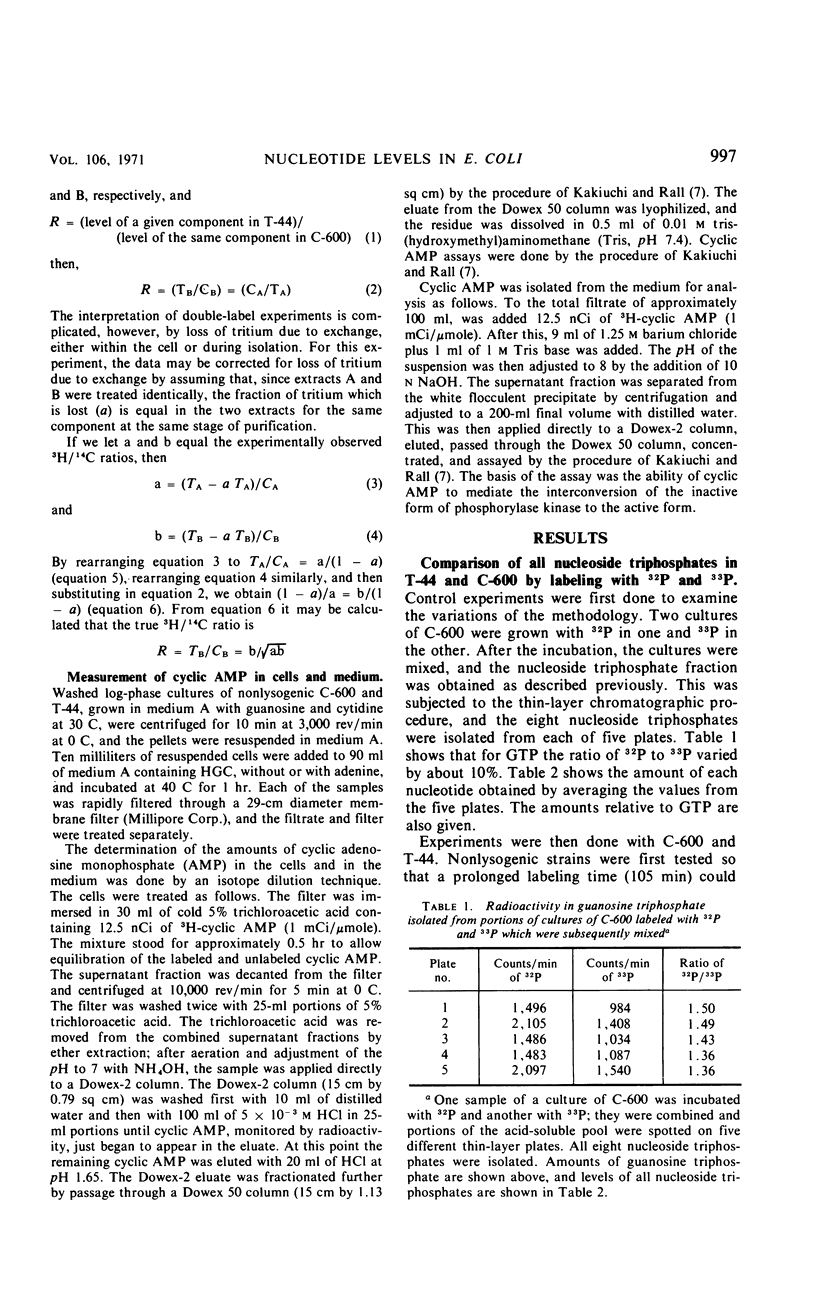Abstract
Cell division and prophage repression in the Escherichia coli mutant, T-44, are very sensitive to the levels of certain purine and pyrimidine derivatives in the media. The hypothesis that a change in the level of an adenine derivative in the small molecule pool of this strain was responsible for prophage induction and filament formation was tested. The nucleoside triphosphate pools in T-44 and C-600 nonlysogenic and lysogenic strains were labeled in experiments with 32P and 33P. Cultures were mixed, and the nucleotides were isolated. When adenine was present, the level of adenosine triphosphate (ATP) in T-44 compared to C-600 (as indicated by the isotope ratio) was increased up to twofold. Most of the other nucleotides increased but not to the same degree. In the lysogenic strain guanosine triphosphate and deoxycytidine triphosphate showed increases comparable to ATP, whereas increases noted in the deoxynucleotides in T-44 ± λ with adenine present were less. In experiments where T-44 and C-600 were incubated with 3H- and 14C-adenine, the levels of several compounds, including ATP, were slightly elevated in T-44. The combined data suggest that cultures of T-44 ± λ, grown in the presence of adenine, show a preferential increase in the level of ATP when compared to C-600 ± λ, but the increase in relation to the other nucleotides is less than twofold. In the experiment with 3H- and 14C-adenine, the level of inosine was found to be increased in T-44 relative to C-600. Cyclic AMP, when added to cultures of T-44 under various conditions, had no effect on prophage induction. Intracellular and extracellular levels of cyclic AMP in T-44 compared to C-600, incubated with had-acidin, guanosine, and cytidine (HGC) or with HGC plus adenine, were not significantly different. No compelling evidence for altered nucleotide metabolism in T-44 ± λ as a cause of prophage induction or filament formation was obtained.
Full text
PDF










Selected References
These references are in PubMed. This may not be the complete list of references from this article.
- Cashel M., Gallant J. Control of RNA synthesis in Escherichia coli. I. Amino acid dependence of the synthesis of the substrates of RNA polymerase. J Mol Biol. 1968 Jul 14;34(2):317–330. doi: 10.1016/0022-2836(68)90256-8. [DOI] [PubMed] [Google Scholar]
- Edlin G., Stent G. S. Nucleoside triphosphate pools and the regulation of RNA synthesis in E. coli. Proc Natl Acad Sci U S A. 1969 Feb;62(2):475–482. doi: 10.1073/pnas.62.2.475. [DOI] [PMC free article] [PubMed] [Google Scholar]
- GOLDTHWAIT D., JACOB F. SUR LE M'ECANISME DE L'INDUCTION DU D'EVELOPPEMENT DU PROPHAGE CHEZ LES BACT'ERIES LYSOG'ENES. C R Hebd Seances Acad Sci. 1964 Jul 20;259:661–664. [PubMed] [Google Scholar]
- Gallant J., Harada B. The control of ribonucleic acid synthesis in Escherichia coli. 3. The functional relationship between purine ribonucleoside triphosphate pool sizes and the rate of ribonucleic acid accumulation. J Biol Chem. 1969 Jun 25;244(12):3125–3132. [PubMed] [Google Scholar]
- Irr J., Gallant J. The control of ribonucleic acid synthesis in Escherichia coli. II. Stringent control of energy metabolism. J Biol Chem. 1969 Apr 25;244(8):2233–2239. [PubMed] [Google Scholar]
- KACZKA E. A., GITTERMAN C. O., DULANEY E. L., FOLKERS K. Hadacidin, a new growth-inhibitory substance in human tumor systems. Biochemistry. 1962 Mar;1:340–343. doi: 10.1021/bi00908a022. [DOI] [PubMed] [Google Scholar]
- Kakiuchi S., Rall T. W. The influence of chemical agents on the accumulation of adenosine 3',5'-Phosphate in slices of rabbit cerebellum. Mol Pharmacol. 1968 Jul;4(4):367–378. [PubMed] [Google Scholar]
- Kirby E. P., Jacob F., Goldthwait D. A. Prophage induction and filament formation in a mutant strain of Escherichia coli. Proc Natl Acad Sci U S A. 1967 Nov;58(5):1903–1910. doi: 10.1073/pnas.58.5.1903. [DOI] [PMC free article] [PubMed] [Google Scholar]
- Neuhard J., Munch-Petersen A. Studies on the acid-soluble nucleotide pool in thymine-requiring mutants of Escherichia coli during thymine starvation. II. Changes in the amounts of deoxycytidine triphosphate and deoxyadenosine triphosphate in Escherichia coli 15 T-A-U. Biochim Biophys Acta. 1966 Jan 18;114(1):61–71. doi: 10.1016/0005-2787(66)90253-x. [DOI] [PubMed] [Google Scholar]
- Neuhard J. Studies on the acid-soluble nucleotide pool in thymine-requiring mutants of Escherichia coli during thymine starvation. 3. On the regulation of the deoxyadenosine triphosphate and deoxycytidine triphosphate pools of Escherichia coli. Biochim Biophys Acta. 1966 Oct 24;129(1):104–115. doi: 10.1016/0005-2787(66)90012-8. [DOI] [PubMed] [Google Scholar]
- Pastan I., Perlman R. Cyclic adenosine monophosphate in bacteria. Science. 1970 Jul 24;169(3943):339–344. doi: 10.1126/science.169.3943.339. [DOI] [PubMed] [Google Scholar]
- Perlman R. L., Pastan I. Regulation of beta-galactosidase synthesis in Escherichia coli by cyclic adenosine 3',5'-monophosphate. J Biol Chem. 1968 Oct 25;243(20):5420–5427. [PubMed] [Google Scholar]
- SHIGEURA H. T. 6-Azauracil inhibition of Escherichia coli B and its reversal by hadacidin. Arch Biochem Biophys. 1963 Mar;100:472–477. doi: 10.1016/0003-9861(63)90114-0. [DOI] [PubMed] [Google Scholar]


